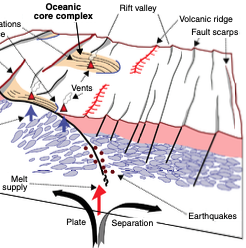Link to online paper: http://publications.iodp.org/proceedings/357/357title.html
Abstract
International Ocean Discovery Program (IODP) Expedition 357 successfully cored an east–west transect across the southern wall of Atlantis Massif on the western flank of the Mid-Atlantic Ridge (MAR) to study the links between serpentinization processes and microbial activity in the shallow subsurface of highly altered ultramafic and mafic sequences that have been uplifted to the seafloor along a major detachment fault zone. The primary goals of this expedition were to (1) examine the role of serpentinization in driving hydrothermal systems, sustaining microbial communities, and sequestering carbon; (2) characterize the tectonomagmatic processes that lead to lithospheric heterogeneities and detachment faulting; and (3) assess how abiotic and biotic processes change with variations in rock type and progressive exposure on the seafloor. To accomplish these objectives, we developed a coring and sampling strategy centered on the use of seabed drills—the first time that such systems have been used in the scientific ocean drilling programs. This technology was chosen in the hope of achieving high recovery of the carbonate cap sequences and intact contact and deformation relationships. The expedition plans also included several engineering developments to assess geochemical parameters during drilling; sample bottom water before, during, and after drilling; supply synthetic tracers during drilling for contamination assessment; acquire in situ electrical resistivity and magnetic susceptibility measurements for assessing fractures, fluid flow, and extent of serpentinization; and seal boreholes to provide opportunities for future experiments.
